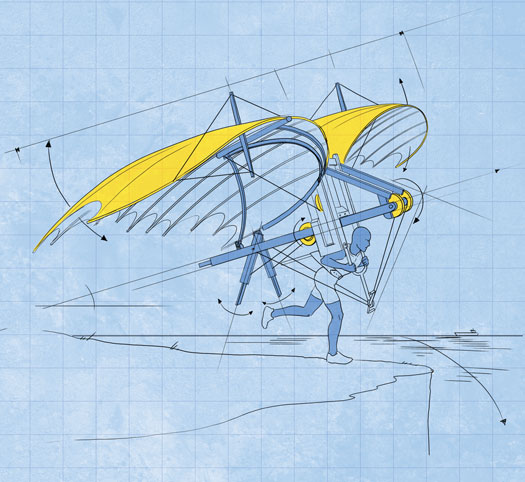

Da Vinci sketched the oldest known plans for a human-powered aircraft in 1485. Yet it wasn’t until 1977 that the first one truly flew. Flight requires lift, when the net air pressure pushing upward counteracts the craft’s weight. For years, many assumed that flight required more lift and more power than the human body alone could provide (although the admonitions did little to stop myriad failed attempts). But inventors persisted.
Aircraft fly using three basic configurations: fixed wing, flapping wing, and rotors. In the last 50 years, inventors have conquered fixed-wing and flapping flight. Now they are on the verge of overcoming the greatest challenge yet: vertical takeoff.
To fly a human-powered helicopter, a pilot would likely have to produce 500 watts of power. Even the fittest pilot could not sustain that output, says Antonio Filippone, an aeronautical engineer at the University of Manchester in England who has published two papers analyzing theoretical human-powered helicopters. “You can lift off,” he says, “But for more than a few seconds, it is not possible.” We’ve heard that sort of thing before.

AIRPLANE
Fixed-wing flight
The Challenge: Fixed-wing flight requires an efficient airfoil, such as a wing that’s curved on top and flat on the bottom. As the airfoil moves forward, air streams faster over its top than underneath it, creating a difference in pressure. When the pressure below the craft overcomes the pressure above it, there is a net upward force. Most planes use engines to get enough forward motion, but people can’t propel a vehicle nearly as fast.

The Solution: In general, the longer the wings, the more lift. In the early ’60s, Southampton University undergraduates built a 130-pound craft with an 80-foot-wingspan and a bicycle-style transmission connected to a propeller. It flew a third of a mile but had significant steering problems. In 1977, engineer Paul MacCready designed the Gossamer Condor, a 70-pound aluminum and plastic craft with a canard—an airfoil on a boom in front of the fuselage. It was more maneuverable than its predecessors and flew in a figure eight around markers a half-mile apart, winning the Royal Aeronautical Society’s prize for the first controlled and sustained human-powered flight. There’s still room for improvement. For example, engineers have refurbished the ’90s Airglow (seen here) with bent wingtips and curvier wings—improvements that stabilize it during turns.

ORNITHOPTER
Flapping-wing flight
The Challenge: Small animals such as hummingbirds beat their wings fast enough to stay aloft entirely from flapping, pushing more air down than they do up and creating a net upward pressure. But at large scales, it’s difficult to beat quickly enough to remain in the air. Bigger flappers, therefore, require a boost from forward thrust. Think of an engine pushing forward a flapping-wing plane, or ornithopter.

The Solution: Larger birds’ wings flap, but they also twist forward and back as if jiggling a doorknob, which generates extra forward thrust. So as a graduate student at the University of Toronto, aeronautical engineer Todd Reichert and fellow students designed their craft, named Snowbird, with wings that both flap up and down and twist 10 degrees. They used computer simulations to fine-tune their design. And they gave Snowbird a wide, 105-foot wingspan and employed carbon fiber and Kevlar to keep it light. A person generates power in the 94-pound craft using a leg press similar to those found in gyms.
On August 2, 2010, on a field in Ontario, a car towed the craft forward until it glided into the air. Then the car stopped towing. As Reichert worked the leg press, the Snowbird flapped its wings and flew on its own at a height of 11 feet for 19.3 seconds, traveling 475 feet.

HELICOPTER
Rotor-based flight
The Challenge: A helicopter flies when its spinning rotors force air down, which decreases air pressure above the craft and increases it below. Unlike planes and ornithopters, helicopters cannot rely on forward motion, making flight much more challenging. Helicopters also generate turbulence that can cause serious stability problems. Several teams are trying to prove that they can conquer vertical flight by winning the American Helicopter Society’s Sikorsky prize, a standing $250,000 award for a human-powered helicopter that hovers for one minute and hits a minimum altitude of three meters (9.8 feet), while staying within a 10-meter (33-foot) square.

The Contenders: The University of Maryland team’s Gamera II helicopter is a quadcopter, a craft with four 42.6-foot-wide rotors connected to a bicycle-like transmission. Several smaller rotors near the ground can lift off more easily than a single large one. They also balance one another for better stability. Each tweak to their design has yielded better results—in June, a pilot sat and pedaled with his hands and feet to raise the Gamera II about a foot off the ground for 49.9 seconds, and then in August, a pilot topped out at eight feet.

Aeronautical engineer Neal Saiki, who designed the first human-powered helicopter to lift off in 1989, is back with a new craft: the Upturn. A pilot pedals to spin its single, 85-foot-wide rotor with four blades, two of which have propellers at their ends, which help with stability. Each blade also has an adjustable flap and a sensor to detect vibration and balance, and Saiki’s software tweaks the flaps’ angles in real time to compensate for wobbles. In June, a pilot lifted the Upturn two feet for about 10 seconds.
The competition is still heating up. Snowbird co-designer Todd Reichert officially registered for the helicopter prize this July with a new group, but it hasn’t yet released a full design of its quadcopter. Maryland continues to improve its craft. Saiki aims to use a stronger pilot. And team gravity will be fighting all of them every step of the way.










